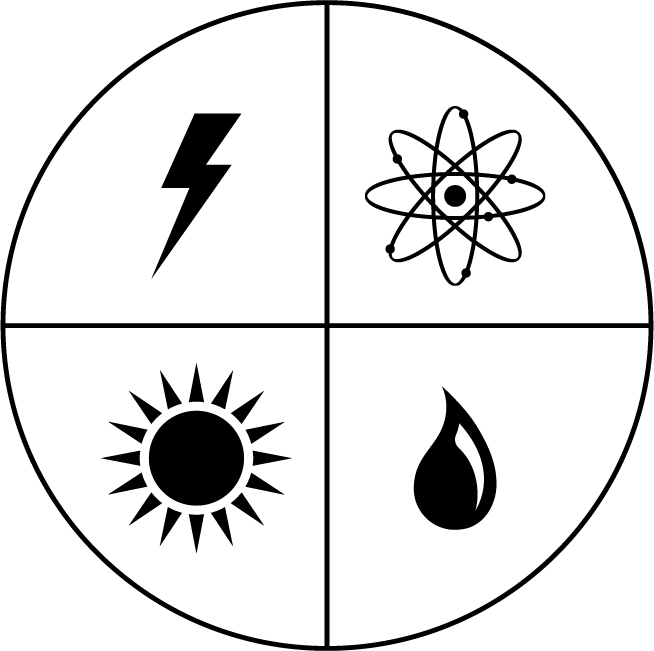Electricity. Fuel. Water. Food. Scarcity Zero and the systems it powers can sustainably deliver all of these resources indefinitely. Yet even with these four resources provided, we still need materials with which to power our ever-evolving economy and build our ever-advancing society. Materials are themselves a resource, and as such they remain subject to the same laws of cost and scarcity as energy resources. Forests get cut down, quarries run dry, and both metal and composites are subject to market forces driven by scarcity.
To address this problem, Scarcity Zero’s next function is to power systems that can synthesize and recycle materials. With these materials, we can build things better, stronger, and less expensively than we can today. Just as importantly, these materials enable us to remove major limitations to our manufacturing capabilities and revolutionize the properties and performance of what we can build. Scarcity Zero’s approach in this context begins with four concepts: advanced synthetics, sophisticated waste management and intelligent recycling, arriving finally at the bleeding-edge of next-generation manufacturing.
Advanced Synthetics
Previous chapters have alluded to technological breakthroughs that have allowed us to build sophisticated systems on scales and at prices that were previously thought impossible. Of these breakthroughs, several have involved the invention of high-performance synthetic polymers – commonly referred to as “plastics.” When we think of plastics, we often imagine substances we’d see around our homes or workplaces: grocery bags, containers, appliance sidings, and the like. These kinds of plastics are commonly used in manufacturing because they are easy to produce at relatively low cost.
Yet plastics have problems. For one, they don’t biodegrade well and they can’t be easily recycled. Consequently – once we’re done with them, they’re stuffed in landfills, or worse, end up in our oceans at severe environmental impact.[1] Additionally, plastics that can be recycled at all have a low “percent yield,” which is the amount of final material produced from the original supply material.[2] That means it might take 10 lbs. of source material to make 1 lb. of plastic, which is too inefficient to be viable on a large scale – especially if the 9 lbs. of material lost as waste is environmentally toxic.[3] We’ve made progress towards solving this problem, but making plastics that have both a high percent yield and are easily recyclable has proven challenging. Recent advances, however, have made reaching this goal more feasible.
The first of these advances is the one that’s made Scarcity Zero possible to begin with: sophisticated computing. Since computers became prevalent in industrial and research settings, their performance has increased at a truly exponential rate. Today, they’re millions of times more powerful than they were in their first iterations.[4] And faster computers – especially boosted by artificial intelligence (A.I.)[5] and machine learning[6] – can help chemical engineers create models to manufacture ever-better synthetic materials.
This becomes all the more possible through quantum computing, a potentially revolutionary method that uses quantum physics to dramatically increase processing speed.[7] Computers today can only process one calculation at a time, whereas quantum computers could, in theory, process millions of calculations simultaneously.[8] While still in its infancy, computer scientists estimate quantum computing could surpass traditional computing as early as 2021,[9] presenting even stronger implications for the future performance of A.I.
Considering that modern computers – while only processing one calculation at a time – can still process quadrillions of calculations per second,[10] speeding this up by a factor of millions could allow for potentially instantaneous data processing of presently daunting calculations. What that allows us to do is model material synthesis with more insight and predict how to create recyclable materials with a higher percent yield at increased efficiency and reduced cost.[11]
The second technological advancement getting us closer to superior plastics is the genetic modification of algae and bacteria to produce specialized hydrocarbons.[12] Accessing such hydrocarbons can give us an increased capability to tailor synthetic materials to fit our needs. With customizable hydrocarbons, ever-better A.I. and quantum computing at our fingertips, we can have more granular control over the composition of source chemicals as well as detailed models that we can use to manipulate those chemicals into plastics and other synthetics that meet demanding performance requirements.[13]
Add in Scarcity Zero’s ability to decrease energy costs, and we have promising new tools that can unite to revolutionize the materials we use to build and improve our world.
We’re already on our way to realizing that future, even with current technology and material limitations. Consider a list of some standouts on the market today:
Nanocomposite plastics. Researchers have discovered that by layering ceramic nanosheets (very thin sheets made from clay) over each other and combining them with a polymer that works in a fashion akin to elementary-school-style white glue, the ceramic nanosheets will interlace with one another like bricks at the molecular level, creating a structure as strong as hardened steel.[14] This suggests that nanocomposite plastics might have a wide array of potential uses, including high-performance applications within aerospace, transportation, defense, and civil engineering.
High-strength polyurethane (Line-X). Polyurethane is a type of polymer that has an extremely high impact tolerance, which makes it durable and useful for shock absorption. While commonly used to finish wood products, more robust varieties perform herculean feats of durability. A practical example is Line-X, a nigh-indestructible spray-on coating used to line the beds of pickup trucks and other industrial machinery.[15] To demonstrate its performance, eggs are coated and dropped off buildings onto concrete, watermelons are coated and driven over with trucks, plastic cups are coated and stepped on by Sumo wrestlers – all without effect, as seen at the links in this citation.[16] While these are admittedly hyperbolic demonstrations of polyurethane’s capabilities, they nonetheless allude to the potential for more practical applications in any instance where flexibility under stress and impact resistance are requirements.
FR-4. The common name for a high-strength, flame-resistant composite made from glass-reinforced epoxy, FR-4 is one of the strongest synthetic materials in the world.[17] Not only is it highly resistant to chemicals (including acids), ultraviolet radiation, and electricity, it is also lightweight and extremely strong.
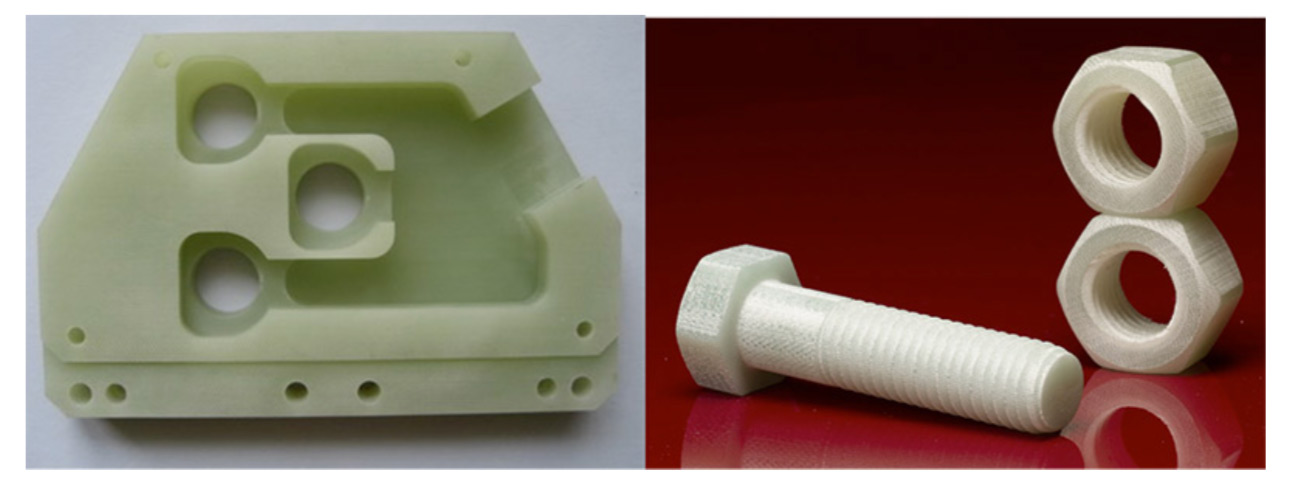
For comparison, the tensile strength of structural steel and aerospace-grade aluminum are ~40,000 PSI and ~43,500 PSI, respectively.[18] The tensile strength of FR-4 is ~45,000 PSI.[19] This allows components made with FR-4 to retain fine detail and be built to extremely tight tolerances, enabling their use in high-precision manufacturing, aerospace and space exploration.
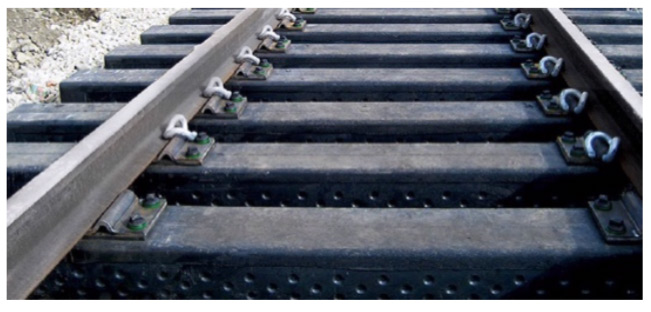 Synthetic wood. Improvements in material science have brought several brands of artificial wood to market. Made from “downcycled” plastics, recycled organic wood and other composites, synthetic wood is used for decks, framing, siding and supports for millions of structures worldwide. It is already a $3.4 billion industry, and it’s still growing.[20] Synthetic wood is fire-resistant and lasts longer than traditional wood. It’s also strong enough to support the weight of a locomotive, as the above image of Ecotrax™ synthetic railroad ties demonstrates.
Synthetic wood. Improvements in material science have brought several brands of artificial wood to market. Made from “downcycled” plastics, recycled organic wood and other composites, synthetic wood is used for decks, framing, siding and supports for millions of structures worldwide. It is already a $3.4 billion industry, and it’s still growing.[20] Synthetic wood is fire-resistant and lasts longer than traditional wood. It’s also strong enough to support the weight of a locomotive, as the above image of Ecotrax™ synthetic railroad ties demonstrates.
This strength allows synthetic wood to potentially replace traditional wood in the construction of houses, buildings, bridges – anything, really. Cost presently remains a limiting factor, but in a world powered by effectively unlimited cheap energy – and with abundant resources – these costs would likely fall substantially, allowing for an indefinite supply of yet another building material.
Superior metallurgy. Metallurgy has been an evolving science for thousands of years, allowing humanity to build ever-greater alloys from combinations of metallic elements. To create these substances, we’ve generally needed three components: base materials, a forge to contain heat, and a source of energy to provide that heat. Building forges that operate at specific heats and pressures has not been prohibitively difficult for some time, so delivering the second component is relatively straightforward.
However, the other two components – source materials and heat energy – have been more elusive, or, at least, more expensive. But we’ve accomplished much with the technology we have today. Researchers have developed new superalloys that push the boundaries of strength-to-weight ratios,[21] new steels as strong as titanium[22] and specialized alloys that can increase the safety and performance of nuclear reactors.[23] A world powered by nigh-unlimited cheap energy and an abundant supply of source materials only stands to accelerate this even further, with improved quality control and more-precise manufacturing following suit.
Although they are samples from a far longer list, these materials and methods are all commercially available as you read this. Each stands to further benefit from the future performance improvements provided by subsequent technological innovation. Yet as impressive as they are, they each ultimately bow in honor of another synthetic material. One that, by itself alone, carries unrivaled potential to revolutionize our way of life. That material is graphene.
The Graphene Key
In Chapter Five, we briefly discussed graphene’s potential to make hydrogen storage tanks. But that’s only the start of its capabilities. As a base concept, graphene is a single atom-thick sheet of carbon that takes the shape of a hexagonal lattice. Extraordinarily thin in form, it has three distinct traits:
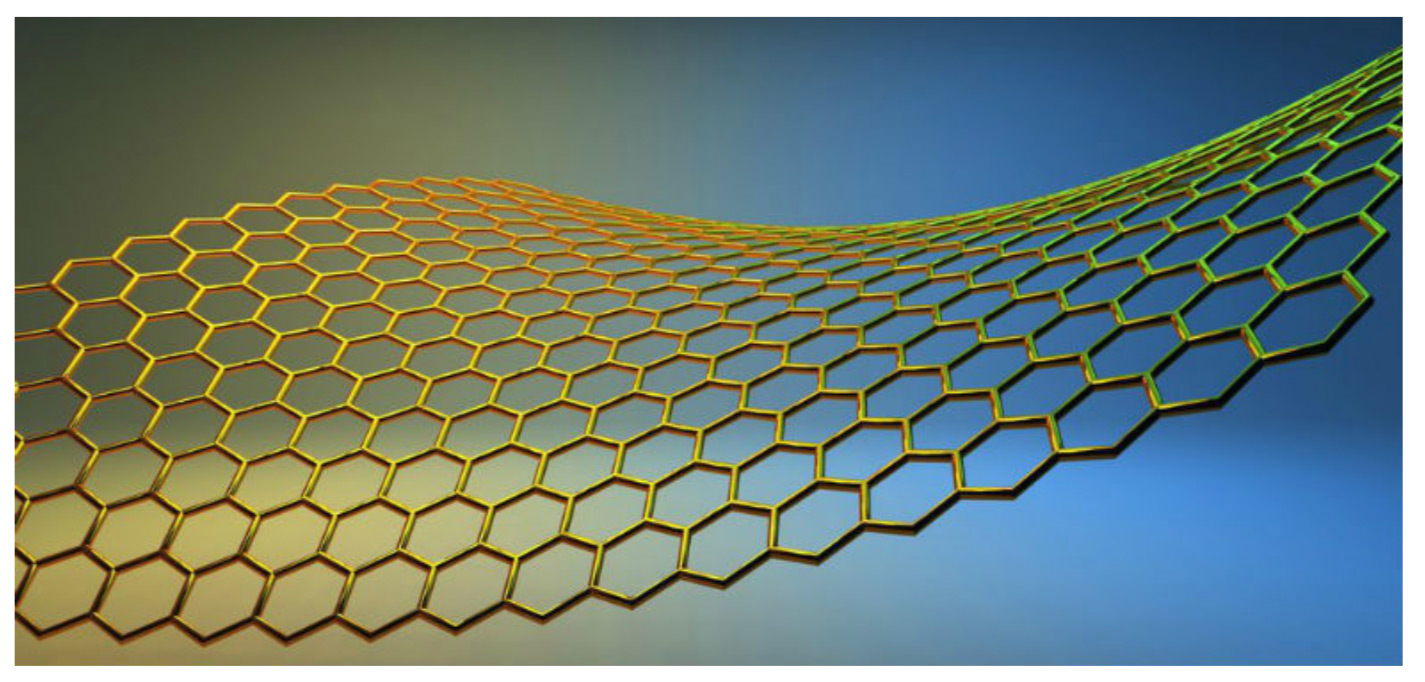
- Extreme strength. With an overall strength roughly 200 times that of hardened steel, graphene is the strongest-known material on Earth – as well as one of the lightest.[24] It’s also highly resistant to both corrosion and heat, with a melting point in excess of 8,132°F (4,500°C). During a 2008 interview with graphene’s inventor, Professor of Engineering John Home at Columbia University, he remarked:
“Our research establishes graphene as the strongest material ever measured, some 200 times stronger than structural steel. It would take an elephant, balanced on a pencil, to break through graphene the thickness of Saran Wrap.”
- Flexibility. As graphene is formed by sheets of carbon as potentially thin as one atom it can retain a rigid structure or be as flexible as a sheet of paper. It can further function at full strength when assuming a range of shapes, even when designed to bend or stretch.
- Conductivity. Graphene is a lattice of carbon atoms, and in such a form is an excellent conductor of electricity.[25] This enables graphene to lend its strength and flexibility to anything electrical – as a function of either transmission, structure, or storage.
The combination of these three traits make graphene uniquely suited for a wide array of applications that serve critical roles in our economy and society.
They include:
Consumer electronics. As an ultra-strong and ultra-conductive material, graphene can be used to create sophisticated electronics that are highly durable. The following images show prototype mobile phones with graphene screens that are both flexible and thousands of times stronger than today’s phone screens.

Electronics made with graphene can also store large amounts of data in small physical spaces.[26] The following images show a concept for a new type of jump drive that works like sticky post-it notes,[27] which while not currently in production are well within the realm of technical feasibility.

Graphene’s conductivity also gives it high capacities for data transfer, some 7,000% faster than today’s technology.[28] Researchers have conducted experiments that show graphene antennas can transmit data at speeds of up to 100 terabytes a second.[29] To contextualize, a high-definition feature-length film generally ranges from 3-9 gigabytes in size. There are 1,000 gigabytes in a terabyte. Assuming an average size of 6 gigabytes, this translates to a transfer capacity of approximately 166 high-definition films per-second.
Medicine. High strength and conductivity with low weight and reactivity gives graphene excellent potential for medical applications.[30] Uses include stents to prevent arterial restriction, high strength and lightweight casts for injuries and providing the physical scaffolding to help paralyzed people walk again.
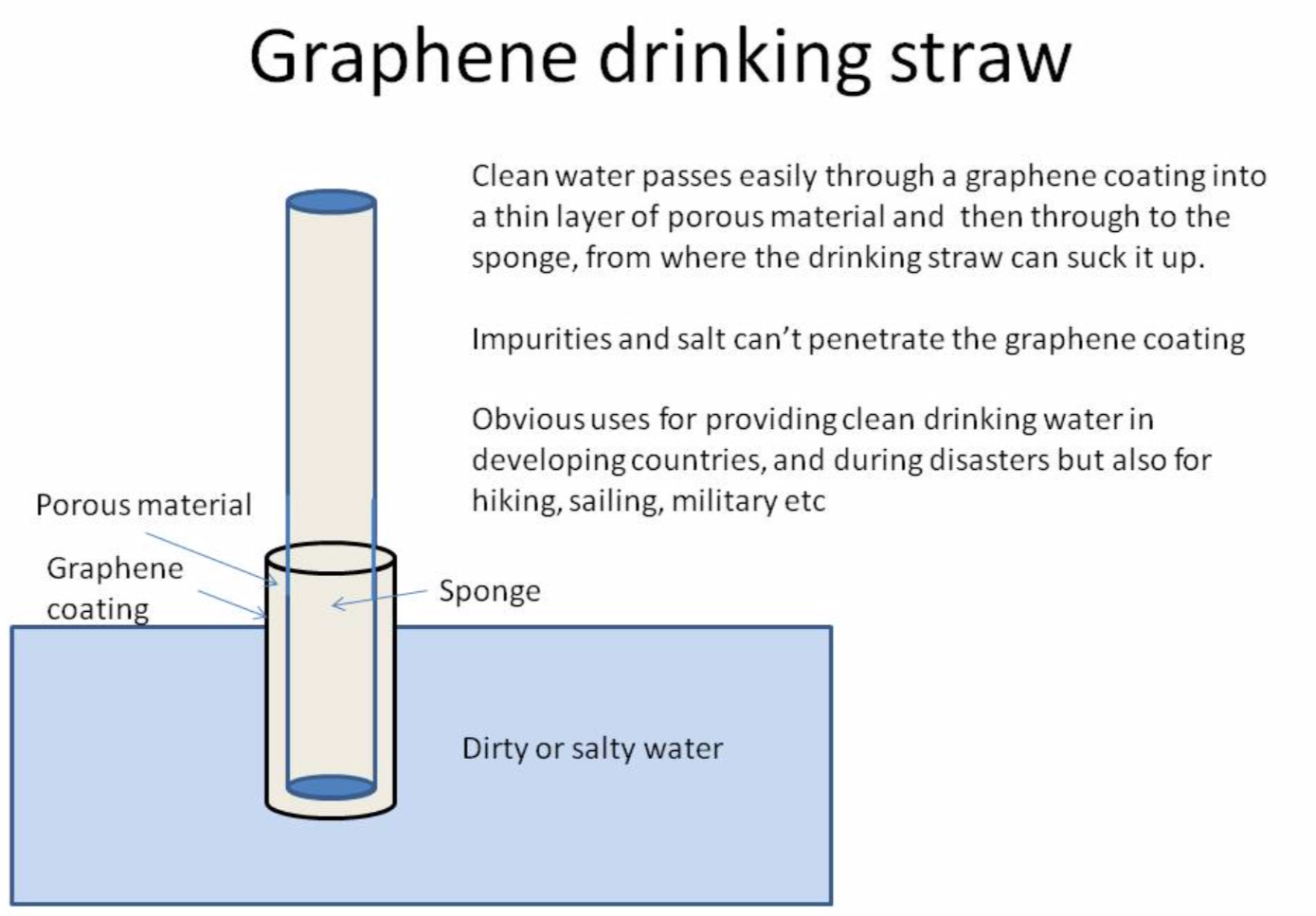 High-performance energy storage. Graphene is uniquely well-suited to hold energy in capacitors, which work through direct energy storage as opposed to batteries that technically require a chemical reaction to generate a charge.[31] Most portable electricity in our day-to-day lives involve batteries, and they’re generally preferred to capacitors because they normally have a higher “energy density” – the amount of energy stored in a system per unit volume.
High-performance energy storage. Graphene is uniquely well-suited to hold energy in capacitors, which work through direct energy storage as opposed to batteries that technically require a chemical reaction to generate a charge.[31] Most portable electricity in our day-to-day lives involve batteries, and they’re generally preferred to capacitors because they normally have a higher “energy density” – the amount of energy stored in a system per unit volume.
But graphene’s different.
Because it’s so thin and conductive, graphene can form “supercapacitors” that can function at equal to even superior levels than high-performance lithium-ion batteries.[32] These supercapacitors are made by layering sheets of graphene between an electrolyte that’s then encased in non-conductive plastic. The following two images show a theoretical cross-section of a graphene capacitor and a real-world prototype of such a capacitor, respectively.
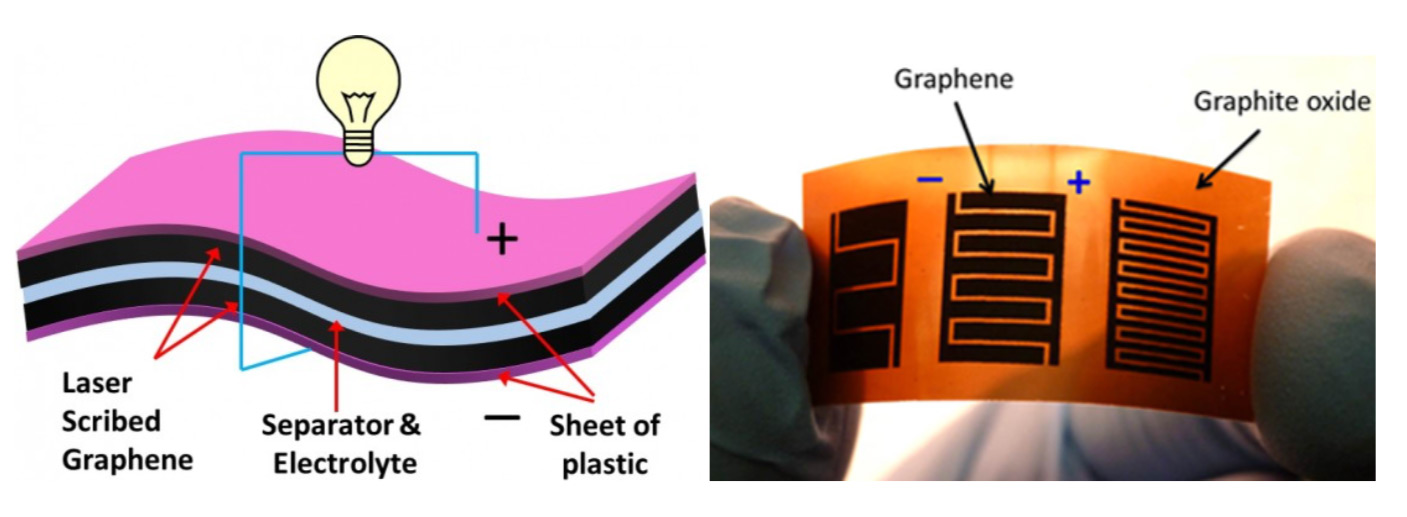
But these prototypes reflect the relatively new emergence of graphene research. As graphene can be made microscopically thin (theoretically to the scale of an atom), advances in manufacturing can eventually enable us to drastically increase the potential surface area of graphene used for direct energy storage.
To conceptualize: let’s imagine a sheet of printer paper, which is 0.1mm thick.[33] Pretty thin, right? For human eyes, certainly, but not when we’re thinking of a substance that could potentially be microscopically thin. Let’s say that we become able to reliably manufacture insulated graphene capacitance sheets to the thickness of a micron (0.001mm). As a sheet of 8.5x11” printer paper has a thickness of 0.1mm,[34] it would take 100 micron-thick sheets of graphene, then, to comprise one sheet of 8.5x11” printer paper. As there are 25.4 millimeters to the inch, we can derive that a one-inch-thick stack of printer paper would have 254 individual pieces. At 100 graphene sheets per piece of paper, that translates to 25,400 sheets of graphene per inch of thickness.
It’s not uncommon for a standard car battery to have a width and depth similar to a sheet of printer paper. If we were to assume a height of ten inches, we could layer as many as 250,000 graphene sheets in that same volume. At 8.5x11”, a sheet of printer paper has a surface area of about 0.65 square feet. At 250,000 sheets strong, that would amount to a total of 162,500 square feet. A football field, for comparison (including end zones) has a surface area of 57,600 square feet.[35] That means this graphene box would contain the equivalent surface area of 2.5 football fields, yet compacted to the size of a car battery – and made with flexible, non-toxic materials that are 600 times lighter than structural steel and 200 times stronger.
A 2017 paper from The Nanotechnology Journal claimed that graphene supercapacitors today can deliver levels of performance that begin to eclipse industry-grade lithium-ion batteries.[36] Lithium-ion batteries are also much heavier, more expensive and have increased environmental and humanitarian costs.[37] That graphene supercapacitors in their infancy can already compete with high-performance lithium-ion batteries – as well as directly interface with hydrogen fuel cells – further supports their candidacy for future deployment as a solid-state energy solution.
Structural material. Extremely strong. Completely flexible – or reliably rigid. Capable of storing tremendous energy in a tiny footprint. Graphene isn’t revolutionary because it’s impressive in each of these categories, it’s revolutionary because it’s impressive in all of these categories.
Consequently, it can transform the way we build things. Take the electric car for instance.
Instead of an electric car storing packs of heavy batteries, the car’s chassis can be interwoven layers of graphene and can itself be the energy storage medium. When you think of the 162,500 square feet of surface area that could be potentially stored within the size of a car battery, an entire vehicle chassis is a subsequently higher order. We could potentially reach points where we could interweave millions of square feet of energy storage medium within a single electric vehicle – increasing range, reliability and structural integrity at far less weight.
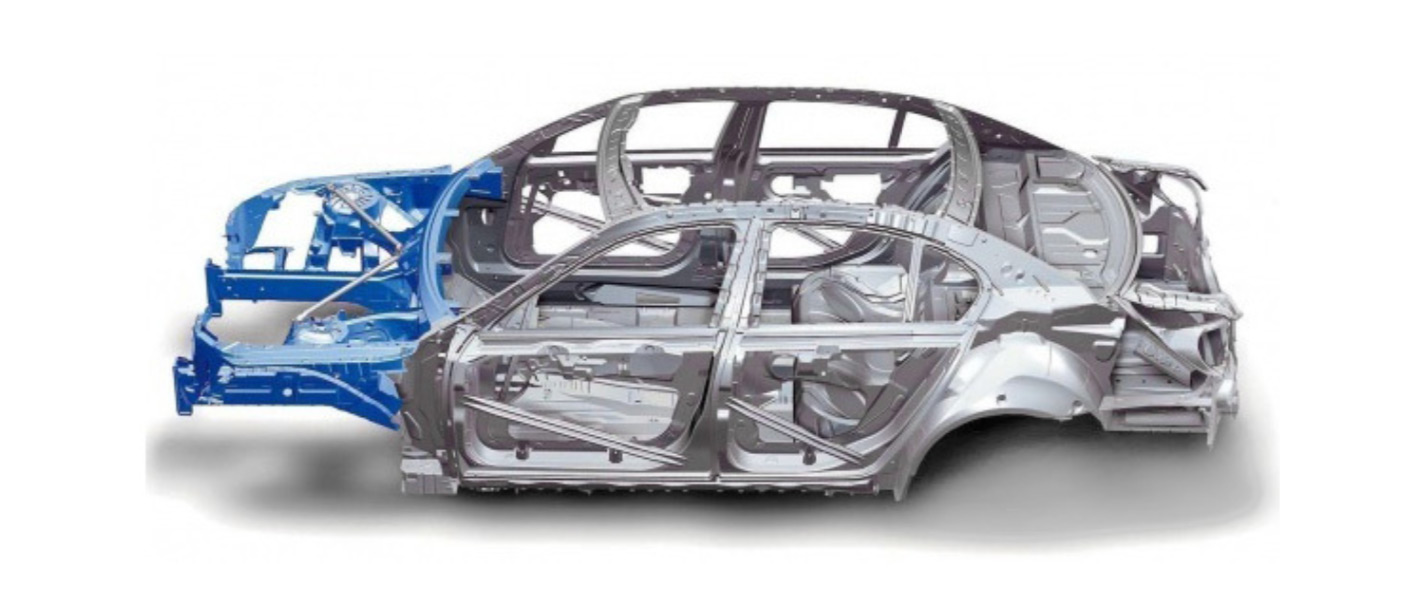
Graphene enables us to wield strength, flexibility in form, and energy storage all at once, each potentially at a higher degree of performance than we can manage with leading commercial solutions today. Tomorrow’s skyscrapers, bridges, public infrastructure, transportation systems – each can also serve as electricity storage. And through Scarcity Zero’s core offerings of electricity, fuel and heat, we have the means to synthesize graphene and other revolutionary materials far easier and at far less expense than we can today.
While this is key to a clean energy future, making things is only one part of the equation. Whatever we construct must in turn be recycled or disposed of in an end-of-life cycle. The framework accounts for this through several approaches on both land – and sea – that can present major environmental improvements.
Next-Generation Waste Management
Technology has brought us the litany of conveniences that define our modern era, yet these conveniences have come with a massive waste footprint – a problem that has proven deeply challenging to manage. We’ve taken several approaches to process our immense volumes of trash: burying it in landfills, attempting to recycle old materials into new materials, “downcycling” waste into usable products (such as making park benches from shredded plastic bottles), or simply burning it. But none have truly succeeded in managing this issue on a global scale.
Scarcity Zero intends to change that. While it’s true that a goal of the framework is improving our ability to recycle things like plastics from the design stage, recycling complex polymers is inherently difficult. And when we consider the extent of waste across the globe, the problem seems daunting, no matter how sophisticated our technology becomes.
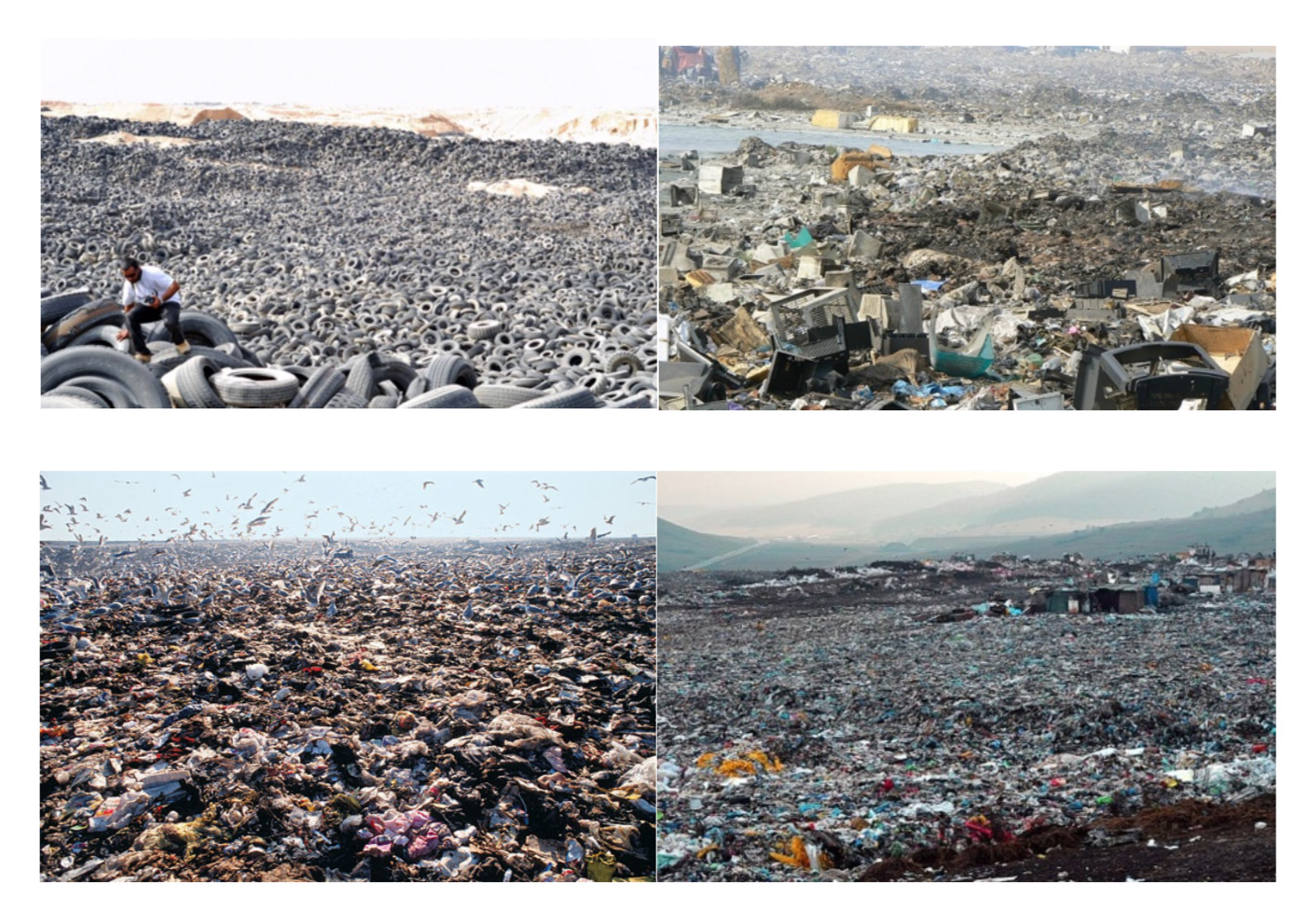
Worse, even while advances in recycling certain materials show promise, and getting rid of single-use plastic products is a laudable goal, each ultimately does little to turn the tide of our global waste accumulation.[38] The solution to this problem must be massive and immediate, effective and achievable – and all on a planetary scale. There presently aren’t many technologies that can meet these requirements, but one called plasma gasification can.[39]
In concept, the “gasification” of waste isn’t much different than incineration – simply burning it as humanity has done for millennia. But gasification uses a high-intensity electric current to create a plasma – an ultra-hot state of ionized gas – to separate trash into two separate states: the first, a material known as “syngas” that can be used as a fuel in myriad applications, as shown on an accompanying overview diagram. The second is an inert slag that can be used to make other useful materials like concrete, roads and insulation.[40]
Plasma gasification itself can also be harnessed as a potent source of energy, which can be used to both sustain its electric current and power other processes.[41] Normal incineration requires fuel and works at much lower temperatures, leaving behind harmful byproducts that present dangers to both public health and the environment. Gasification avoids these issues completely.
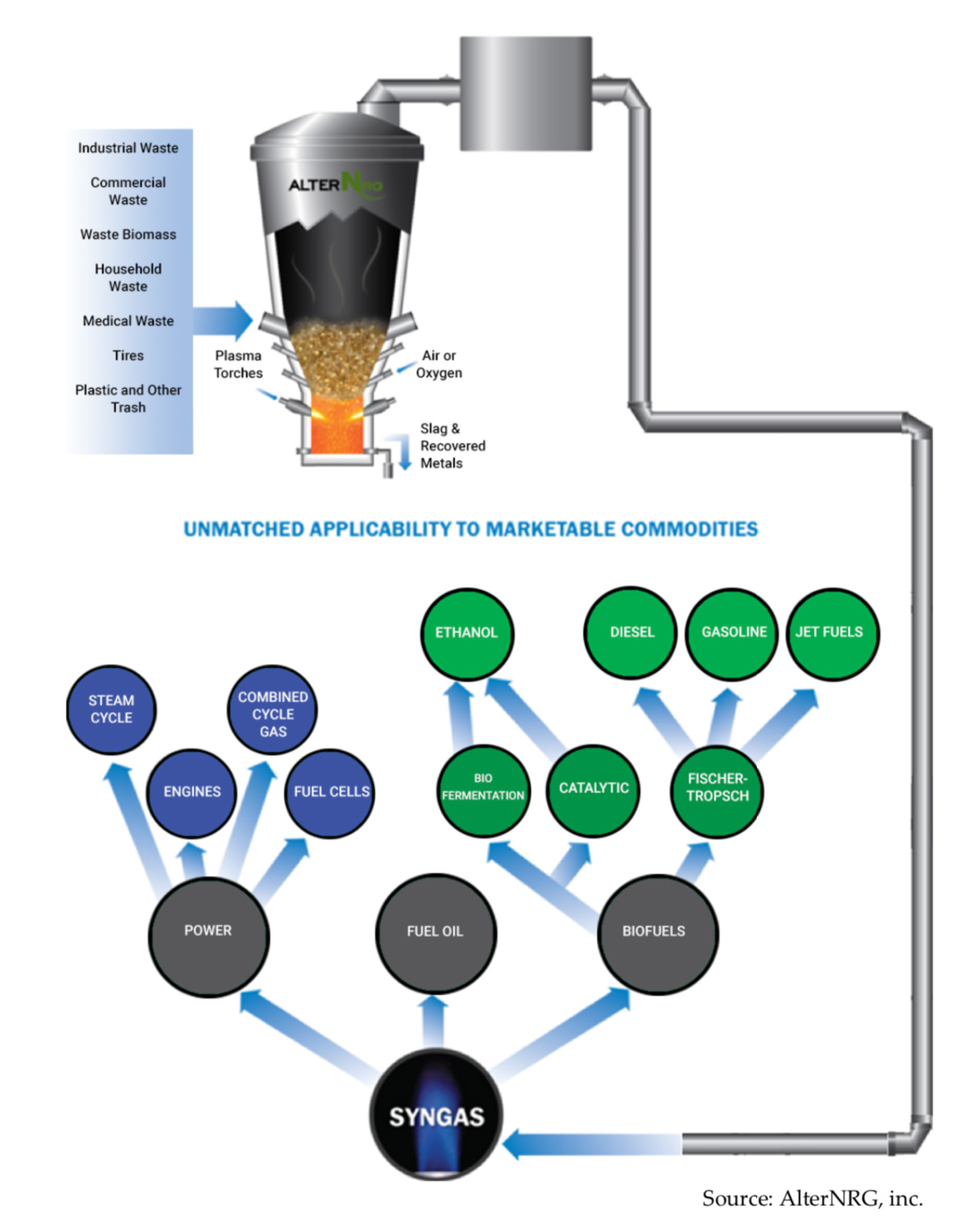
| Plasma Gasification | Incineration (burning) | |
|---|---|---|
| Temperature | High temperature, 1,400-1,600 °C | Medium heat (870-1200 °C) |
| Emissions | Does not create air pollutants | Allows toxic atmospheric pollutants to form. |
| Byproducts | ~99% of waste material becomes usable material. | ~30% of the waste material remains as toxic ash. |
| Useful Products | Syngas and an inert slag which is used in building materials and roads. | None. Incineration is among the most expensive and polluting methods of waste management. |
| Power | Generates power.[42] | Requires fuel. |
Plasma gasification is an integral part of Scarcity Zero, that when partnered with other technologies in the framework, brings sophisticated waste management to any energy-generating ensemble. This application is vital to a clean energy future that presents minimal impact to Earth’s ecology. But it can be applied further to an even more critical task: cleaning our oceans.
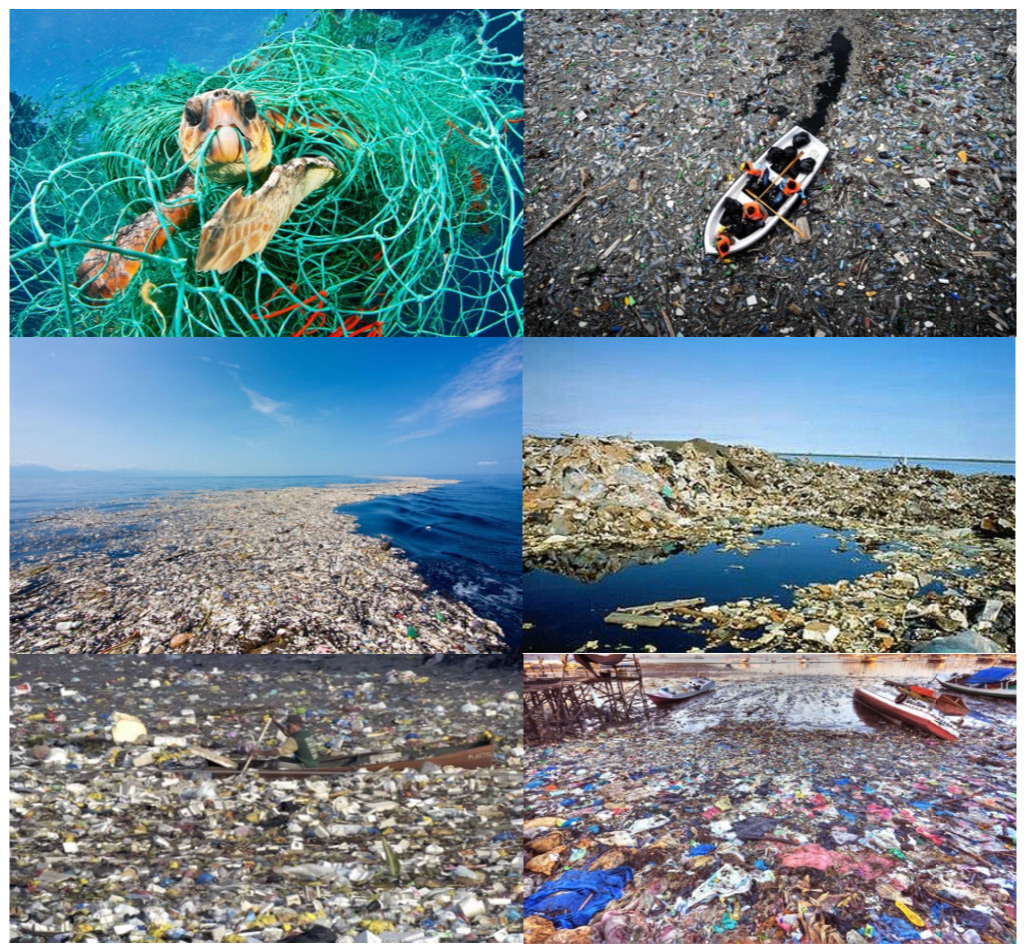
Over decades of mass extraction, global consumerism and irresponsible waste disposal, ocean trash has become a major problem on. There’s so much plastic and garbage floating in Earth’s seas today that it’s now accumulated into patches that are thousands of miles across.
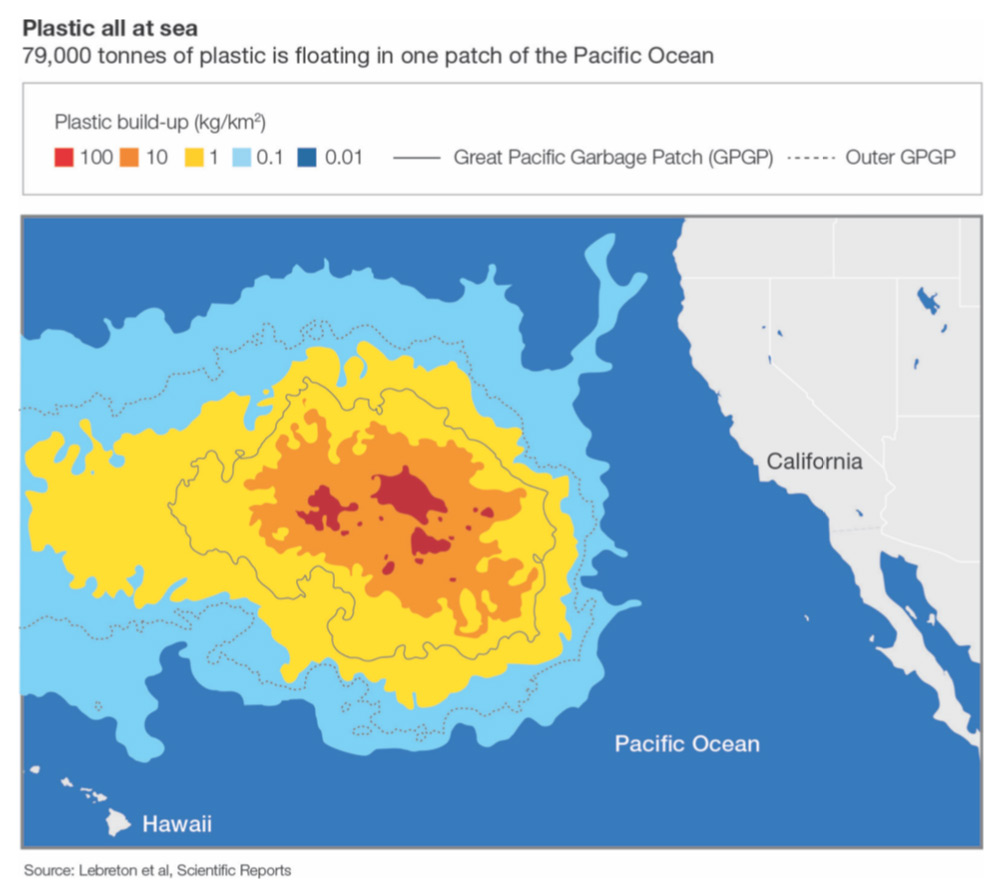
Each major ocean has a large accumulation of trash within primary ocean currents (referred to as “gyres.”)[44] The picture above outlines the “great pacific garbage patch,” one of five worldwide.
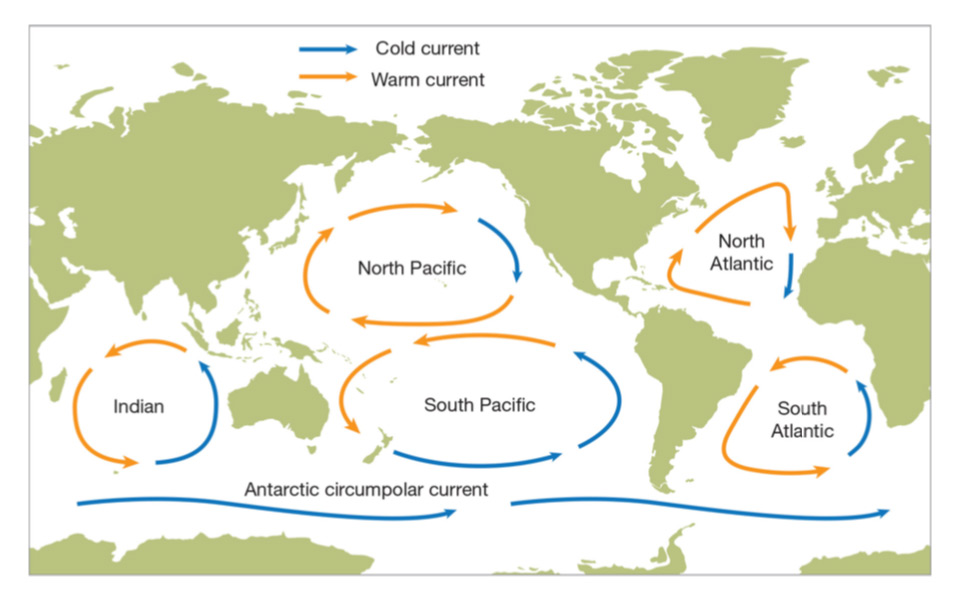
Worse, waste from these massive piles is continually decomposing into smaller pieces – and these smaller pieces are being consumed by marine life. This poisons the creatures it doesn't kill, which eventually makes its way into humans when we eat seafood. Currently, some 3.2 billion people rely on seafood for almost 20 percent of their animal protein intake.[45]
Science and society are aware of this problem and have invented promising tools to help reverse course. The Ocean Cleanup Project, for instance, recently launched a gigantic sieve consisting of floating pipes and netting that corrals trash into a U-shape for future processing.[46] In concept, several of these sieves would float with ocean currents to slowly accumulate ocean trash over time, with the hope of eventually improving marine environments.
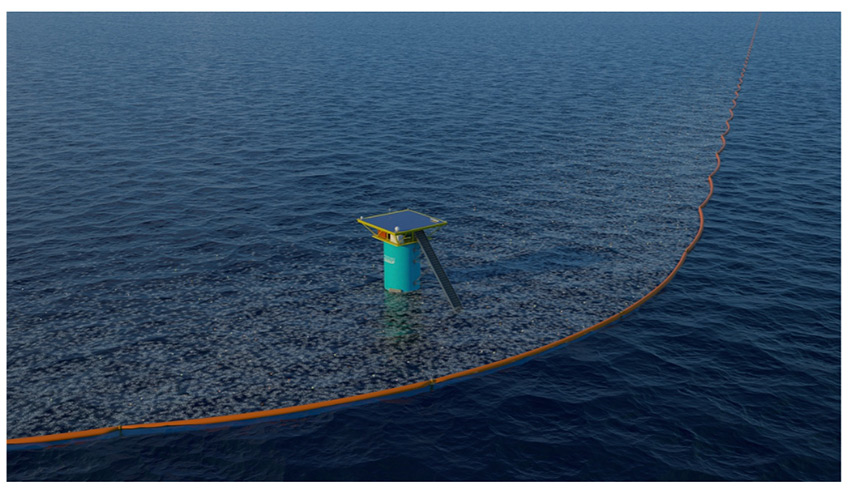
But that step of “accumulation” presents another important question. Once the trash is corralled, what do we do with it? And how does cleaning up ocean trash in one place prevent it from being reintroduced to marine environments elsewhere? Scarcity Zero’s answer to this question is called a “Trident Facility.”
A Trident Facility is built like an offshore oil rig – a large floating facility that can navigate any ocean in the world. Yet instead of drilling for oil, it would both synthetically produce resources and dispose of ocean trash cleanly and safely.
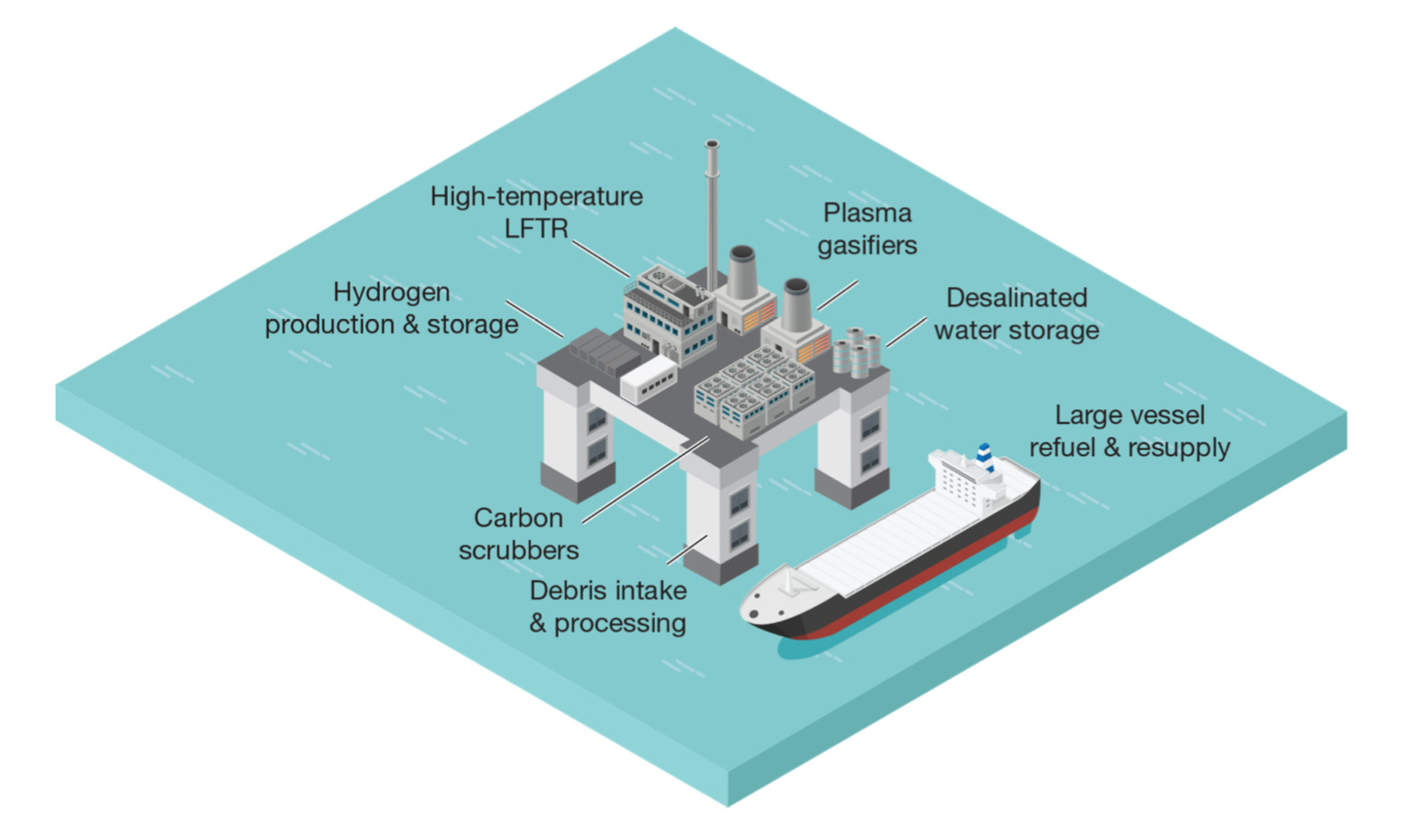
Here’s how they would work:
- The primary power source of a Trident Facility is a small LFTR, which provides the core power for the plasma gasification of ocean trash and the residual energy needed to power auxiliary, resource-producing systems.
A cooperating series of Trident Facilities would scour the oceans and suck in trash from one of their four floating legs or a central lift. Ideally, these would work in conjunction with floating trash collectors like those from the Ocean Cleanup Project. From there, trash would be processed via a plasma gasifier to become syngas or the slag that can be turned into useful materials.
- The excess energy generated from the LFTR and the plasma gasifier would be further used to extract fresh water and hydrogen fuel from seawater, just as with CHP Plants. This could be used to resupply large ships on-demand, enabling Trident Facilities to serve as de-facto ports or emergency safe havens.
- Beyond trash gasification, hydrogen production, and seawater desalination, any excess energy produced by Trident Facilities would be used to power atmospheric scrubbers to reduce air pollution and greenhouse gasses in the atmosphere.
Trident facilities earn their namesake because they perform three unique roles: ocean cleanup, resource production and atmospheric scrubbing: three points of Poseidon’s trident. They enable us to work to eradicate ocean trash, while using the byproducts to make useful materials. This helps us come ever closer to the material revolution Scarcity Zero seeks to make the new normal.
The Circular Economy
We build thousands of products on an industrial scale today, but once those products become obsolete, the materials used in them have often not been recycled or repurposed outside of scrap yards. Engineering and financial limitations, difficulties with transporting materials to recycling locations, extant systems with which to recycle them, and the energy necessary to power those systems are all limiting factors. With Scarcity Zero, it becomes easier to take a sophisticated machine, strip out non-recyclable materials and send them off for plasma gasification, and extract recyclable substances that remain – retaining them for use elsewhere in manufacturing and fabrication.
The underlying concept behind this approach is commonly referred to as a “Circular Economy” – an economic system aimed at reducing waste and maximizing efficiency through the continual re-use of resources and materials.[47] In most instances, implementations of circular economies seek to minimize the use of new resources and the creation of waste, pollution and greenhouse gas emissions, and instead employ concepts of refurbishment, remanufacturing and intelligent recycling at scale to keep already-present resources and materials in play.[48] The underlying idea is that “waste” is contextual, and opposed to a traditional “linear economy” that functions on a production model of “extract, manufacture, sell and dispose” a circular economy leverages as many technological methods as feasible to enable regenerative resources and materials for the “circular” reproduction – and upgrade – of systems in a model that’s as closed-loop as possible.[49]
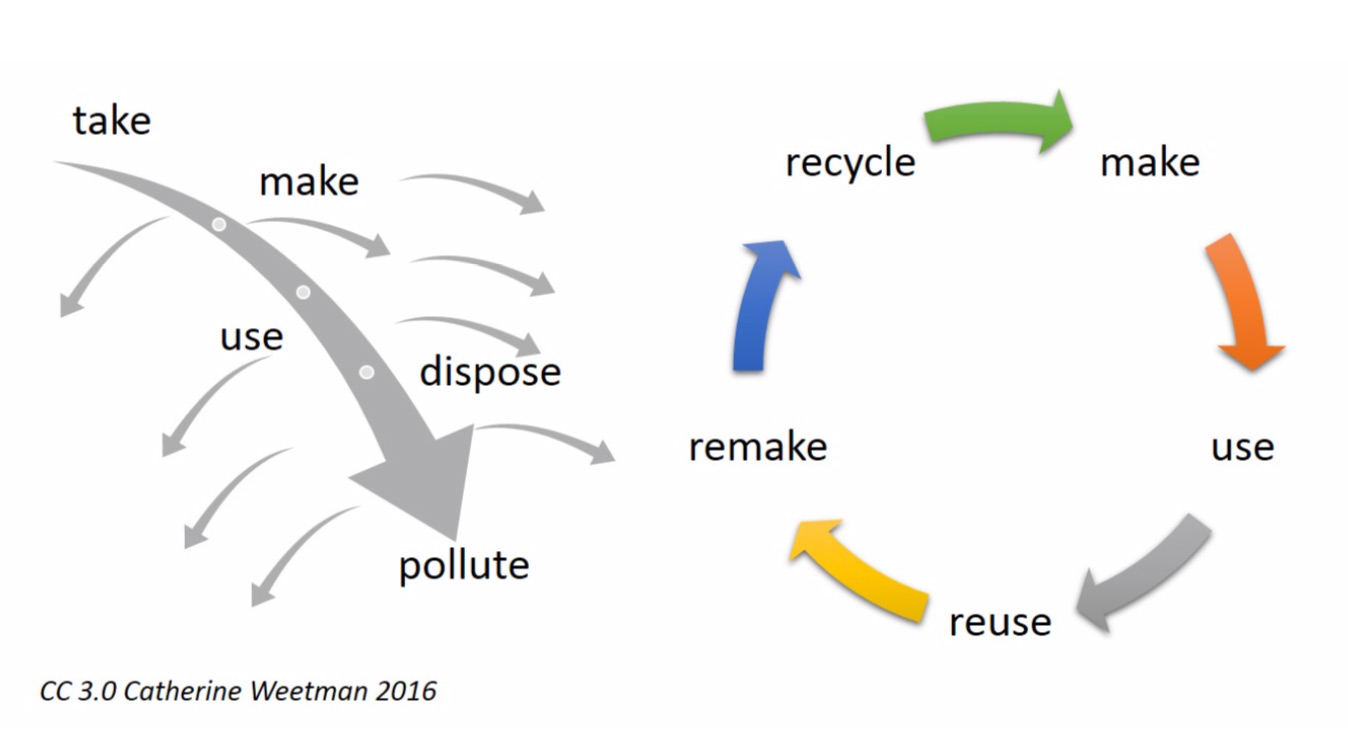
Implementations of circular economies are not necessarily novel concepts, and the systems that can perform such processes already exist today. But Scarcity Zero significantly increases the scale at which this can be accomplished while lowering energy and resource costs. As a result, we would be able to supplement next-generation manufacturing with recycled metals and materials more effectively than we can today, both reducing the need to acquire new materials and enabling the expansion of circular economic models on larger scales – nationwide, or even global. Not only does this improve how we can build things from the design stage, it fundamentally transforms our capabilities to manufacture, recycle and upgrade advanced systems. Examples include:
Intelligent deconstruction. Many products today are simply too complex to be recycled cost-effectively. Consequently, once discarded, they are often thrown in landfills. Reduced energy and material expenses, modern computer systems, and novel engineering methods have lowered the costs of recycling consumer electronics, vehicles, ships, buildings, and airplanes. And as we improve how those things are recycled – or more specifically, disassembled and recycled – this gives us the opportunity to tweak our manufacturing methods to build products that can be disassembled, recycled, and/or upgraded in a modular capacity.
Reduced costs and material requirements. Beyond removing energy as a significant expense, the ability to repurpose older models into newer ones means we don’t have to build new products from scratch. For example: instead of a vehicle going to a scrap yard once it gets old, we could instead engineer that vehicle to be stripped down to its basic components by a factory and refurbished into a newer model – a concept that could be applied to essentially any product.
This form of recycling benefits both consumers and manufacturers. It gives consumers the ability to exchange obsolete models for credit toward a newer model and reduces the expenses and sweat equity manufacturers pay to acquire materials and create products. These benefits contribute to cost savings for both parties, and also increase the agility of manufacturing by allowing us to do more with what we have currently. Plenty of companies strive to reach this goal, but increasing the number of companies who do so alongside advances in energy generation and material procurement increases the efficacy of this recycling method – promoting its adoption within a greater share of market sectors.
Reduced waste footprint. Waste management, an abundant supply of cheap energy, indefinite supplies of synthetic materials, and deconstruction-focused engineering reduces the waste footprint of manufacturing processes. With Scarcity Zero, we wouldn’t build as many products at the expense of the environment, nor would we build products that are destined for landfills. By upgrading and reconnecting our energy production, material procurement, and manufacturing and recycling infrastructure, the lifecycle of a product is contained from start to finish – reducing nature’s presence in the equation.
From Here, We Have Now Reached Three Important Goals:
- With Scarcity Zero, it becomes much easier to make next-generation synthetics that can outperform even the most advanced materials we have today – synthetics that we can use to build and improve practically anything.
- With Scarcity Zero, we can dispose of waste and recycle products far easier and at greater scale than we can at present.
- With goals #1 and #2 met, we can now design systems and products to eventually be disassembled, repurposed, and/or upgraded – turning products into long-term investments instead of one-use discardables.
Combined with computer-aided manufacturing methods like additive/3D printing, this can transform the way our society manufactures products.[50] Traditionally, such manufacturing approaches have allowed companies to rapidly prototype new designs or hobbyists to make improved or replacement parts for various projects.

However, advances in commercial applications of this technology have revolutionized the capabilities present at our fingertips, enabling us to manufacture complex multidimensional shapes and even the preliminary foundations for replacement organs.[51]

One example with strong industrial potential is present in modern metal 3D printing, such as models from the MarkForged company – a leader in 3D metal printing innovation.
MarkForged’s Metal-X models are capable of building complex shapes to the micron or better tolerances out of high-strength thermoplastics, fiberglass, Kevlar, carbon fiber, titanium and both stainless and high-strength tool steel.[52] According to their already-at-market commercial data sheets, their printing methods can build shapes up to 100 times less expensively than traditional casting or machining.[53]
The following three images respectively show a pump impeller, camshaft sprocket and aircraft bracket printed with their technology.
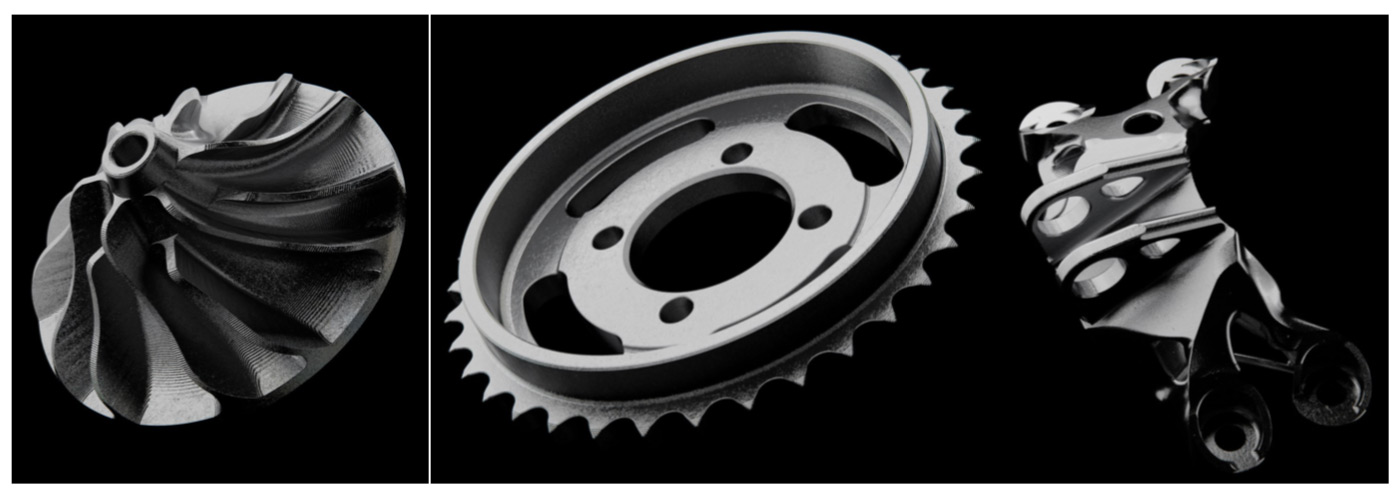
Another example is “selective laser melting” – a method of applying a high-intensity laser to a bed of fine metallic powder (steel, aluminum, titanium, metallic alloy or graphene composite) to manufacture highly detailed shapes, also at micron-or-better tolerances, that meet the highest material strengths commercially available.[54]
Like 3D metal printing, these shapes can reflect practically any attribute that can be envisioned on any axis, and be either solid, hollow, or solid with embedded pathways for isolated fluids.
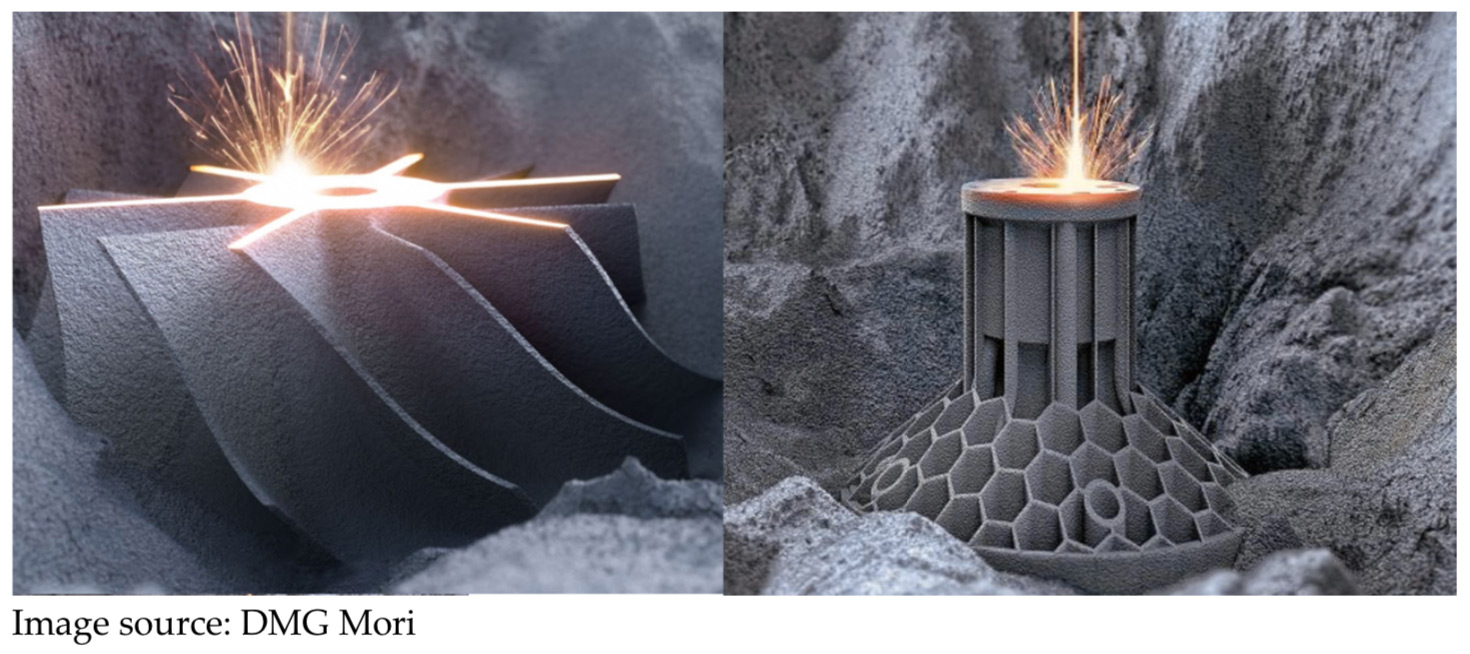


Without question, the sophistication and precision of these capabilities raises the bar of our manufacturing prowess to uncharted heights. Yet because their deliverables can now also be manufactured as iterative models of products at the push of a button – and can also further be built using the strongest and most resilient materials presently available – these advances can be integrated into any aspect of a modular, standardized and scalable manufacturing chain.
Combined, this changes the game completely – all the more so since these technologies are in their infancy and stand to advance over time with proportionally higher sophistication and proportionally reduced costs. It’s the last piece of the puzzle that we require to build whatever we could need or want. When backed by a technical framework that provides effectively unlimited energy and critical resources by design, this enables us to extend that capability to any social sector we could imagine. And that, in sum, allows us to land the final blow to defeat resource scarcity outright.
